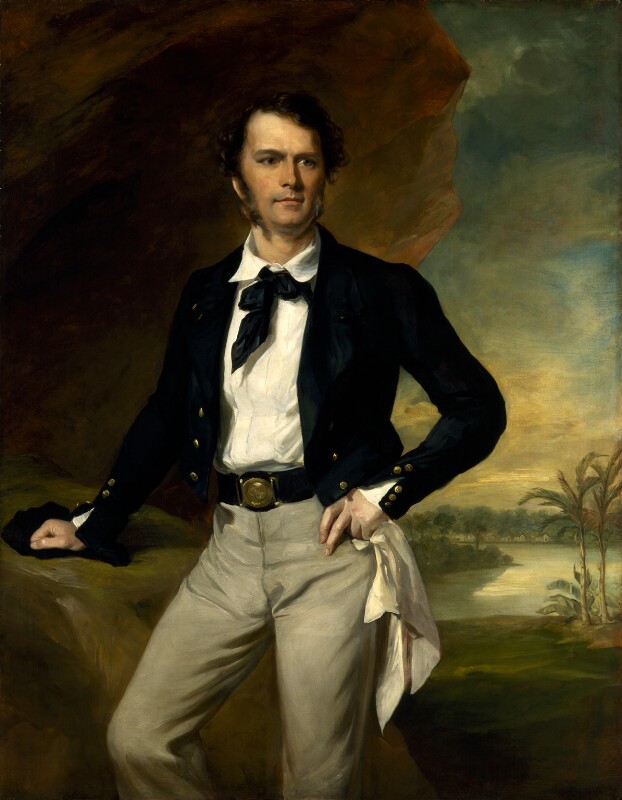History[edit]
See also: Kingdom of Sarawak and Anti-cession movement of Sarawak
The eastern seaboard of Borneo was charted, though not settled, by the Portuguese in the early 16th century. The area of Sarawak was known to Portuguese cartographers as Cerava. During the 17th century, Sarawak was self-governed under Sultan Tengah. By the early 19th century, Sarawak had become a loosely governed territory under the control of the Brunei Sultanate. During the reign of Pangeran Indera Mahkota in 19th century, Sarawak was facing chaos.[7] Sultan Omar Ali Saifuddin II (1827–1852), the Sultan of Brunei, ordered Pangeran Muda Hashim in 1839 to restore order and it was during this time that James Brooke arrived in Sarawak. Pangeran Muda Hashim initially requested assistance in the matter, but Brooke refused. In 1841, Brooke paid another visit to Sarawak and this time he agreed to provide assistance. Pangeran Muda Hashim signed a treaty in 1841 surrendering Sarawak and Sinian to Brooke. On 24 September 1841, Pangeran Muda Hashim bestowed the title Governor to James Brooke. He effectively became the Rajah of Sarawak and founded the White Rajah Dynasty of Sarawak, later extending his administration through an agreement with the Sultan of Brunei. Sarawak was thus an independent kingdom from 1841 until 1888, when the state was placed under British protection.
Brooke Dynasty[edit]
James Brooke was appointed Rajah by the Sultan of Brunei on 18 August 1842. Brooke ruled the territory, later expanded, across the western regions of Sarawak around Kuching until his death in 1868. His nephewCharles Anthoni Johnson Brooke became Rajah after his death; he was succeeded on his death in 1917 by his son, Charles Vyner Brooke, with the condition that Charles should rule in consultation with his brotherBertram Brooke.[8] The Sarawak territories were greatly enlarged under the Brooke dynasty, mostly at the expense of areas nominally under the control of Brunei. In practice Brunei had only controlled strategic river and coastal forts in much of the lost territory, so most of the gain was at the expense of Muslim warlords and of the de facto independence of local tribes.
The Brooke dynasty ruled Sarawak for a hundred years and became famous as the "White Rajahs", accorded a status within the British Empire similar to that of the rulers of Indian princely states. In contrast to many other areas of the empire, however, the Brooke dynasty was intent on a policy of paternalism in order to protect the indigenous population against exploitation. They governed with the aid of the Muslim Malay and enlisted the Ibans and other "Dayak" as a contingent militia. The Brooke dynasty also encouraged the immigration of Chinese merchants but forbade the Chinese to settle outside of towns in order to minimise the impact on the Dayak way of life. Charles Brooke, the second White Rajah of Sarawak, established the Sarawak Museum, the oldest museum in Borneo.
In the early part of 1941 preparations were afoot to introduce a new constitution, designed to limit the power of the Rajah and give the people of Sarawak a greater say in government. Despite this democratic intention, the draft constitution contained irregularities, including a secret agreement drawn up between Charles Vyner Brooke and his top government officials, financially compensating him via treasury funds.[9]
Second World War and occupation[edit]
Main article: Japanese occupation of British Borneo
Japan invaded Sarawak and occupied the island of Borneo in 1941, occupying Miri on 16 December and Kuching on 24 December, holding both territories for the duration of World War II until the area was secured by Australian forces in 1945. Charles Vyner Brooke formally ceded sovereignty to the British Crown on 1 July 1946, under pressure from his wife among others. In addition, the British Government offered a healthy pension to Brooke.
Anthony Brooke continued to claim sovereignty as Rajah of Sarawak. After the end of the World War II, Anthony Brooke then opposed the cession of the Rajah's territory to the British Crown, and was associated with anti-secessionist groups in Sarawak. For this he was banished from Sarawak and he was allowed to return only seventeen years later, when Sarawak became part of Malaysia. Sarawak became a British colony (formerly an independent state under British protection) in July 1946, but Brooke's campaign continued. The Malays in particular resisted the cession to Britain, dramatically assassinating the second British governor, Sir Duncan George Stewart.
Independence[edit]
Sarawak was officially granted independence on 22 July 1963, and joined with Malaya, Sabah, and Singapore, in the federation of Malaysia,[10][11] formed on 16 September 1963, despite the initial opposition from parts of the population.[12][13] Sarawak was also a flashpoint during the Indonesian Confrontation between 1962 and 1966.[14][15]

No comments:
Post a Comment